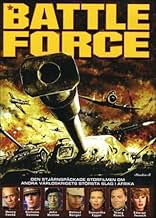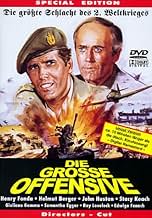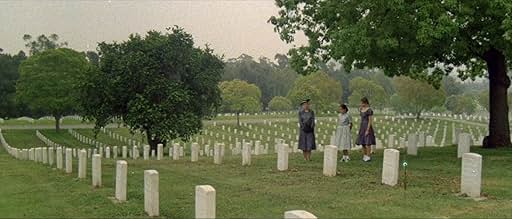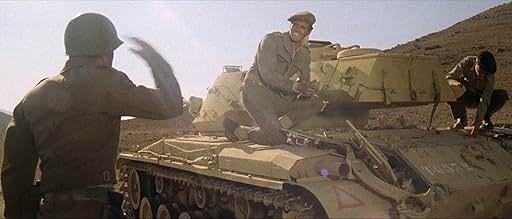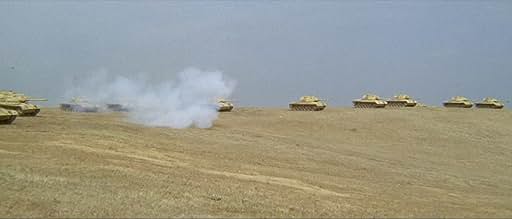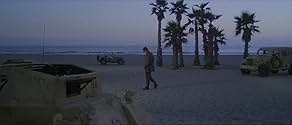NOTE IMDb
4,7/10
629
MA NOTE
Ajouter une intrigue dans votre langueHow World War II affected the lives of a German family and an American family, both of whom had sons and fathers fighting in the war.How World War II affected the lives of a German family and an American family, both of whom had sons and fathers fighting in the war.How World War II affected the lives of a German family and an American family, both of whom had sons and fathers fighting in the war.
- Réalisation
- Scénario
- Casting principal
Ida Galli
- Sybil Scott
- (as Evelyn Stewart)
Rik Battaglia
- French Partisan
- (as Rick Battaglia)
Avis à la une
This spectacular movie starts in Berlin during Oympic Games 1936 with the African-American Jesse Owens as champion . There reunites a Nazi officer (Stacy Keach) , a veteran American journalist (John Huston), a famous actress (Samantha Eggar) and an US General (Henry Fonda). Keach gives gifts to the hosts captioning : 'In God we trust' . The group of different nationalities vows to meet five years later but WWII interrupts their lives . Los Angeles 1942 , the upright General incarnated by Henry Fonda is assigned to West Point Academy and his son (Ray Lovelock) takes the ranks to North African campaign . After the action is placed on several locations , as London , West Point, Le Hauvre (France) . Island of Creta , October 1942, an official (Giuliano Gemma) whose mission is to destroy a German installation before being used against the Allied forces . Following the feats about Partisans and a parachuted squadron (led by Giacomo Rossi Stuart) attacking a train (commanded by Helmut Berger) transporting a big German-built cannon (whose scenes are taken from ¨Battle of commands¨). Meanwhile the German actress (Samantha Eggar)for the reason his Jewish origin is detained by SS and Nazi official Berger is enamored to prostitute (gorgeous Edwige Fenech) . Posteriorly , it tells battles in Mareth line March 14, 1943 and Gabes , North Africa , engaging war German Army against British VIII army . There a captain (Gemma) neutralizes a bomb camp and Nazi officer (Berger) impersonates Allied soldier to destroy supplies . Taking place spectacular battles with miniaturized tanks (whose footage is taken from ¨Battle of Alaimen¨ by Giorgo Ferroni and the same producer Mino Loy) .
This is a regularly conceived WWII with action filled , studio character , drama and exciting battles , but nothing special . Packs inaccurate details and an extremely talented though wasted cast make this one of all-time great Italian epic productions though failed . The film contains news-reel documentary , stock-shots vignettes and miniatures , however lost continuity with several cuts and zooms . The battle scenes were shot in desert of Tabernas (Almeria) where in the 60s and 70s were filmed lots of Westerns . Furthermome, a prestigious cast , as Fonda , Eggar , Keach and appears as narrator the great Orson Welles . Numerous Italian secondaries as Jack Stuart , Andrea Bosic , Venantino Venanti , Ken Wood , Ida Valli and Rick Battaglia habitual of Peplum and Spaghetti . The tale was middlingly directed by Umberto Lenzi , he often used the pseudonym Hank Milestone and Humphrey Logan . He's an expert on wartime genre such as he proved in ¨ Desert commandos¨ , ¨Battle of commandos¨, ¨From hell to victory¨, and ¨Bridge to hell¨.
This is a regularly conceived WWII with action filled , studio character , drama and exciting battles , but nothing special . Packs inaccurate details and an extremely talented though wasted cast make this one of all-time great Italian epic productions though failed . The film contains news-reel documentary , stock-shots vignettes and miniatures , however lost continuity with several cuts and zooms . The battle scenes were shot in desert of Tabernas (Almeria) where in the 60s and 70s were filmed lots of Westerns . Furthermome, a prestigious cast , as Fonda , Eggar , Keach and appears as narrator the great Orson Welles . Numerous Italian secondaries as Jack Stuart , Andrea Bosic , Venantino Venanti , Ken Wood , Ida Valli and Rick Battaglia habitual of Peplum and Spaghetti . The tale was middlingly directed by Umberto Lenzi , he often used the pseudonym Hank Milestone and Humphrey Logan . He's an expert on wartime genre such as he proved in ¨ Desert commandos¨ , ¨Battle of commandos¨, ¨From hell to victory¨, and ¨Bridge to hell¨.
I don't understand how Luciano Martino and Mino Loy were able to raise the money to hire so many big-name actors of the time (such as Orson Welles, John Huston, Henry Fonda, and Samantha Eggar) but they still had to rely on plentiful stock footage from earlier war movies like THE BATTLE OF EL ALAMEIN and LEGION OF THE DAMNED. Pretty much all the substantial action scenes featured here consist of lifted shots from late 60's films, giving it an overall dated appearance.
Umberto Lenzi's directing is good as usual, with lots of emphasis placed on the well-edited action scenes. The budget for production design and extras casting appears minimal however, with a lot of the same actors dying over and over again, and a few really shoddy toy tanks exploding.
As for the cast, just about everybody that had anything to do with the Italian movie industry shows up somewhere in the movie, from familiar dubbing voice Robert Spafford as Patton to future director Michele Soavi as Fonda's dead son. The photography and music are all top notch, yet this movie has gotten ad reviews across the board. Why? My guess is that it's because it has little or no plot to speak of. There are so many characters and so much going on in the film that it has no focus or direction. Eggar's character has no point in the movie other than she makes it slightly longer, and Edwige Fenech gets one lousy scene as a French prostitute. Eventually, most of the actors end up in Africa fighting on one side or the other and (surprise!) the Germans lose and all the German characters die, the end. But who goes to watch a good old-fashioned war movie for the plot anyway? There's plenty to enjoy if you like watching German soldiers lying in the road pretending to be dead so they can shoot the American soldiers that run up to help them. It also contains a number of memorable scenes like when Stacy Keach gets lost in the desert and falls over after about 10 seconds of walking, and a very irritating case of bad communication when Ray Lovelock attempts to call up his father and the two barely manage to get through even a few words.
The ending really comes out of nowhere though, but it's made especially funny as John Huston seems to just get bored of the movie and walk off saying "seeya around" right into the camera! The extended European cut at least provides a little more closure and overall much less disjointed, though it's missing the Orson Welles narration which so desperately tries to tie everything together. Definitely not a movie to miss... for fans of the Italian war movie sub-genre and those curious to see a sort of dry run for the WINDS OF WAR miniseries.
Umberto Lenzi's directing is good as usual, with lots of emphasis placed on the well-edited action scenes. The budget for production design and extras casting appears minimal however, with a lot of the same actors dying over and over again, and a few really shoddy toy tanks exploding.
As for the cast, just about everybody that had anything to do with the Italian movie industry shows up somewhere in the movie, from familiar dubbing voice Robert Spafford as Patton to future director Michele Soavi as Fonda's dead son. The photography and music are all top notch, yet this movie has gotten ad reviews across the board. Why? My guess is that it's because it has little or no plot to speak of. There are so many characters and so much going on in the film that it has no focus or direction. Eggar's character has no point in the movie other than she makes it slightly longer, and Edwige Fenech gets one lousy scene as a French prostitute. Eventually, most of the actors end up in Africa fighting on one side or the other and (surprise!) the Germans lose and all the German characters die, the end. But who goes to watch a good old-fashioned war movie for the plot anyway? There's plenty to enjoy if you like watching German soldiers lying in the road pretending to be dead so they can shoot the American soldiers that run up to help them. It also contains a number of memorable scenes like when Stacy Keach gets lost in the desert and falls over after about 10 seconds of walking, and a very irritating case of bad communication when Ray Lovelock attempts to call up his father and the two barely manage to get through even a few words.
The ending really comes out of nowhere though, but it's made especially funny as John Huston seems to just get bored of the movie and walk off saying "seeya around" right into the camera! The extended European cut at least provides a little more closure and overall much less disjointed, though it's missing the Orson Welles narration which so desperately tries to tie everything together. Definitely not a movie to miss... for fans of the Italian war movie sub-genre and those curious to see a sort of dry run for the WINDS OF WAR miniseries.
This film has the unmistakable whiff of tax write off about it and I can't believe the non-Italians in this Italian made World War II film weren't doing this one for nothing more than a paycheck and a European vacation.
For an Italian film you would think Italy would be mentioned somewhere in this story. The climax of the movie is the battle for Tunisia where the Italians had a lot of soldiers. The battle scenes are merely stock footage from other and better films.
The only tie in this whole story is a meeting in Berlin of retired army general Henry Fonda, war correspondent John Huston, German-Jewish actress Samantha Eggar and German major Stacy Keach. Meeting at the time of the Olympics there, the four dismiss the possibility of war.
After that it seems like you're watching four or five separate films all at once. Everyone seems to be just reciting the dialog by rote and hurrying off to do better things presumably. Even Orson Welles who narrates the English language version, can't whip up any excitement in his voice.
It's just another one done for the money.
For an Italian film you would think Italy would be mentioned somewhere in this story. The climax of the movie is the battle for Tunisia where the Italians had a lot of soldiers. The battle scenes are merely stock footage from other and better films.
The only tie in this whole story is a meeting in Berlin of retired army general Henry Fonda, war correspondent John Huston, German-Jewish actress Samantha Eggar and German major Stacy Keach. Meeting at the time of the Olympics there, the four dismiss the possibility of war.
After that it seems like you're watching four or five separate films all at once. Everyone seems to be just reciting the dialog by rote and hurrying off to do better things presumably. Even Orson Welles who narrates the English language version, can't whip up any excitement in his voice.
It's just another one done for the money.
Shot in 1978, during a decade saturated with revisionist interpretations and international co-productions, this film offers a compelling-if at times uneven-exercise in ensemble war storytelling. Situated within the well-worn terrain of the Second World War's European theater, the movie positions itself among those sprawling, multithreaded narratives that attempt to span not only geographical borders but ideological ones as well. The context of its production is essential: the late '70s saw Italy-and much of Europe-grappling with political turbulence, post-1968 disillusionment, and a cinematic shift toward more ambivalent portrayals of heroism. In this light, the film's ideological subtext oscillates between a residual admiration for wartime sacrifice and a growing skepticism about military valor as pure virtue, a tension which is perceptible both in its mise-en-scène and in its performance style.
Cinematically, the movie is ambitious but occasionally overstretches its reach. Its use of Panavision widescreen is effective, especially in the battle scenes and troop movements, which are clearly influenced by the visual grammar of American epics such as A Bridge Too Far (1977). Yet while that film benefited from a cohesive aesthetic and a consistent tone, this one seems torn between dramatic gravitas and exploitation-film spectacle. The lighting in interior scenes often veers into soap-operatic territory, with overly diffused sources flattening what should be moments of claustrophobia or moral tension. Exteriors fare better: winter settings are appropriately grim, and the muddy palettes, likely informed by the Italian neorealist residue still lingering in European cinematography, create an effective contrast with the more glamorized combat scenes.
The editing style is indicative of its time, favoring rapid intercutting that sometimes undermines narrative clarity. This is especially evident in the crosscutting between parallel plotlines, which appear to compete rather than complement each other. The result is a certain dissonance in pacing-moments of reflection are too often interrupted by sequences that feel included for spectacle's sake rather than narrative necessity. This narrative fragmentation mirrors to some extent the thematic pluralism of the film, but it comes at a cost: emotional investment is scattered, and the film never quite manages to fully inhabit any one of its many story arcs.
Performance-wise, the ensemble cast reflects the Euro-American co-production strategy typical of the period. While some of the actors bring a credible pathos to their roles-particularly those portraying rank-and-file soldiers caught in the grind of orders and ideology-others seem to be playing archetypes rather than characters, delivering their lines with a theatricality more suited to dubbed television dramas than war cinema. This disjointedness in acting styles-possibly due to linguistic and cultural differences among the cast-adds another layer of fragmentation to the viewing experience. Nevertheless, in moments of silence or shared glances, the film achieves a kind of understated poignancy rarely found in more bombastic entries of the genre.
The score, though derivative, provides a steady undercurrent that ties together the disparate narrative threads. It leans heavily on brass and martial motifs, occasionally lapsing into over-sentimentality, especially during scenes of sacrifice or reunion. Still, it functions adequately within the genre's expectations. In comparison with The Eagle Has Landed (1976), which also juggles espionage, infiltration, and multinational perspectives, this film is less taut in structure but more visually expressive, even if that expression often borders on melodrama.
Thematically, the movie straddles several registers: it wants to condemn the machinery of war while simultaneously indulging in its aesthetics. This contradiction reflects the sociopolitical moment of its production, when audiences were both weary of grand narratives and nostalgic for collective struggle. Its antiwar gestures-though present-are undermined by its reliance on spectacle and its occasional descent into near-pulp portrayals of violence. Unlike Cross of Iron (1977), which maintained a consistent tone of moral ambiguity and psychological depth, this film struggles to reconcile its stylistic bravado with the gravity of its subject matter.
The film's most effective sequences are those that slow down and allow for the materiality of war to be felt: the weight of uniforms soaked in blood and mud, the tactile despair of soldiers sleeping in trenches, the silence after an artillery barrage. In those moments, the film edges closer to the kind of micro-historical sensibility found in Stalingrad (1993), albeit lacking its single-minded focus. But such instances are fleeting. Too often, the film returns to its panoramic scope, sacrificing intimacy for narrative sprawl.
Technically, the use of practical effects and pyrotechnics is commendable, especially given the limited budget typical of European co-productions at the time. These sequences, while less polished than those of contemporaneous American productions, possess a rawness that suits the film's more grounded aspirations. The sound design, however, occasionally fails to match the intensity of the visuals-explosions are muffled or mistimed, and the mix tends to flatten battlefield acoustics rather than accentuate their chaos.
As a product of its time, this movie reveals much about the shifting cultural memory of the Second World War in 1970s Europe. It attempts to be many things-a tapestry of wartime experiences, a critique of militarism, an action vehicle, and a meditative homage-and in trying to balance these aims, it falters as often as it succeeds. Yet its ambition and its willingness to foreground European perspectives on an often Anglo-American dominated genre render it a valuable, if flawed, entry in the corpus of World War II cinema.
Cinematically, the movie is ambitious but occasionally overstretches its reach. Its use of Panavision widescreen is effective, especially in the battle scenes and troop movements, which are clearly influenced by the visual grammar of American epics such as A Bridge Too Far (1977). Yet while that film benefited from a cohesive aesthetic and a consistent tone, this one seems torn between dramatic gravitas and exploitation-film spectacle. The lighting in interior scenes often veers into soap-operatic territory, with overly diffused sources flattening what should be moments of claustrophobia or moral tension. Exteriors fare better: winter settings are appropriately grim, and the muddy palettes, likely informed by the Italian neorealist residue still lingering in European cinematography, create an effective contrast with the more glamorized combat scenes.
The editing style is indicative of its time, favoring rapid intercutting that sometimes undermines narrative clarity. This is especially evident in the crosscutting between parallel plotlines, which appear to compete rather than complement each other. The result is a certain dissonance in pacing-moments of reflection are too often interrupted by sequences that feel included for spectacle's sake rather than narrative necessity. This narrative fragmentation mirrors to some extent the thematic pluralism of the film, but it comes at a cost: emotional investment is scattered, and the film never quite manages to fully inhabit any one of its many story arcs.
Performance-wise, the ensemble cast reflects the Euro-American co-production strategy typical of the period. While some of the actors bring a credible pathos to their roles-particularly those portraying rank-and-file soldiers caught in the grind of orders and ideology-others seem to be playing archetypes rather than characters, delivering their lines with a theatricality more suited to dubbed television dramas than war cinema. This disjointedness in acting styles-possibly due to linguistic and cultural differences among the cast-adds another layer of fragmentation to the viewing experience. Nevertheless, in moments of silence or shared glances, the film achieves a kind of understated poignancy rarely found in more bombastic entries of the genre.
The score, though derivative, provides a steady undercurrent that ties together the disparate narrative threads. It leans heavily on brass and martial motifs, occasionally lapsing into over-sentimentality, especially during scenes of sacrifice or reunion. Still, it functions adequately within the genre's expectations. In comparison with The Eagle Has Landed (1976), which also juggles espionage, infiltration, and multinational perspectives, this film is less taut in structure but more visually expressive, even if that expression often borders on melodrama.
Thematically, the movie straddles several registers: it wants to condemn the machinery of war while simultaneously indulging in its aesthetics. This contradiction reflects the sociopolitical moment of its production, when audiences were both weary of grand narratives and nostalgic for collective struggle. Its antiwar gestures-though present-are undermined by its reliance on spectacle and its occasional descent into near-pulp portrayals of violence. Unlike Cross of Iron (1977), which maintained a consistent tone of moral ambiguity and psychological depth, this film struggles to reconcile its stylistic bravado with the gravity of its subject matter.
The film's most effective sequences are those that slow down and allow for the materiality of war to be felt: the weight of uniforms soaked in blood and mud, the tactile despair of soldiers sleeping in trenches, the silence after an artillery barrage. In those moments, the film edges closer to the kind of micro-historical sensibility found in Stalingrad (1993), albeit lacking its single-minded focus. But such instances are fleeting. Too often, the film returns to its panoramic scope, sacrificing intimacy for narrative sprawl.
Technically, the use of practical effects and pyrotechnics is commendable, especially given the limited budget typical of European co-productions at the time. These sequences, while less polished than those of contemporaneous American productions, possess a rawness that suits the film's more grounded aspirations. The sound design, however, occasionally fails to match the intensity of the visuals-explosions are muffled or mistimed, and the mix tends to flatten battlefield acoustics rather than accentuate their chaos.
As a product of its time, this movie reveals much about the shifting cultural memory of the Second World War in 1970s Europe. It attempts to be many things-a tapestry of wartime experiences, a critique of militarism, an action vehicle, and a meditative homage-and in trying to balance these aims, it falters as often as it succeeds. Yet its ambition and its willingness to foreground European perspectives on an often Anglo-American dominated genre render it a valuable, if flawed, entry in the corpus of World War II cinema.
Not bad at all for an Italian war spaghetti film. Of course it is not BATTLE OF THE BULGE, BATTLE OF ENGLAND nor THE LONGEST DAY either but the international cast helps much. Not a bad story, not so far from historical accuracy, good convincing acting and poignant scenes too. Excellent battle sequences. I have seen far worse in terms of Italian spaghetti war films. Here, at least, the German army - Afrika Korps - is not shown as silly soldiers - which they certainly were not - and a difference is made between SS - Gestapo - and the Wehrmacht. I enjoyed it very much. I guess there are many more films like this, Italian movie industry from the late sixties and late seventies provided so many of them.
Le saviez-vous
- GaffesIn one of the scenes the American Flag has fifty stars, as it does now, but that flag was not adopted until Monday, July 4, 1960. The flag that should have been shown, which the Americans during World War Two served under, was the forty eight-star Stars and Stripes, which was valid from Thursday July 4, 1912 to Friday July 3, 1959, and is even seen hanging high in Grand Central Station in Hitchcock's North by Northwest.
- Citations
German in Danielle's room: A French whore should work with her hips and not her lips!
- Versions alternativesThe American release has been dubbed into English. The titles have been translated to English. However, on the Direct Source Special Products Home Video Release, the film remains dubbed in English, yet the opening and ending titles have been redone using modern computer technology. The opening features the title BATTLE FORCE, and credits the film's director Humphrey Longan as Humphrey Logan; credits actress Edwige Fenech as Edwige French; and claims the cast listing to be in alphabetical order, which it is not.
- ConnexionsEdited from La légion des damnés (1969)
Meilleurs choix
Connectez-vous pour évaluer et suivre la liste de favoris afin de recevoir des recommandations personnalisées
- How long is The Biggest Battle?Alimenté par Alexa
Détails
- Date de sortie
- Pays d’origine
- Langues
- Aussi connu sous le nom de
- The Biggest Battle
- Lieux de tournage
- Venice, Californie, États-Unis(beach scenes)
- Sociétés de production
- Voir plus de crédits d'entreprise sur IMDbPro
Contribuer à cette page
Suggérer une modification ou ajouter du contenu manquant

